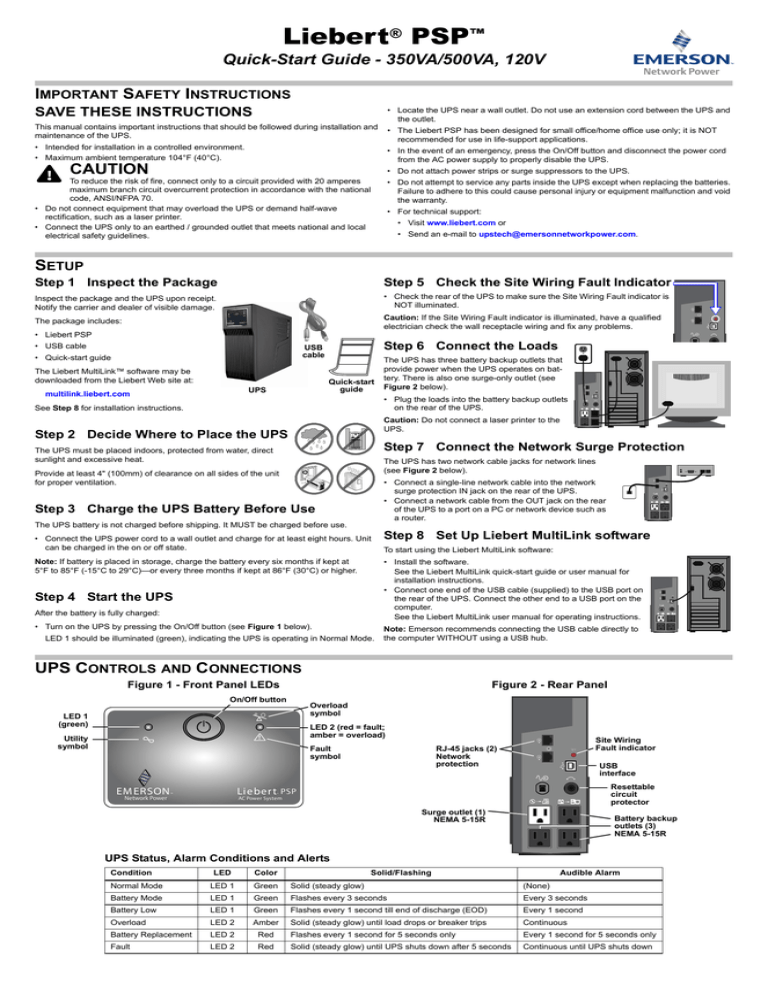
Liebert® PSP™
Quick-Start Guide - 350VA/500VA, 120V
IMPORTANT SAFETY INSTRUCTIONS
SAVE THESE INSTRUCTIONS
• Locate the UPS near a wall outlet. Do not use an extension cord between the UPS and
the outlet.
This manual contains important instructions that should be followed during installation and
maintenance of the UPS.
• The Liebert PSP has been designed for small office/home office use only; it is NOT
recommended for use in life-support applications.
• Intended for installation in a controlled environment.
• Maximum ambient temperature 104°F (40°C).
• In the event of an emergency, press the On/Off button and disconnect the power cord
from the AC power supply to properly disable the UPS.
! CAUTION
To reduce the risk of fire, connect only to a circuit provided with 20 amperes
• Do not attach power strips or surge suppressors to the UPS.
• Do not attempt to service any parts inside the UPS except when replacing the batteries.
Failure to adhere to this could cause personal injury or equipment malfunction and void
the warranty.
maximum branch circuit overcurrent protection in accordance with the national
code, ANSI/NFPA 70.
• Do not connect equipment that may overload the UPS or demand half-wave
rectification, such as a laser printer.
• Connect the UPS only to an earthed / grounded outlet that meets national and local
electrical safety guidelines.
• For technical support:
• Visit www.liebert.com or
• Send an e-mail to upstech@emersonnetworkpower.com.
SETUP
Step 1 Inspect the Package
Step 5 Check the Site Wiring Fault Indicator
Inspect the package and the UPS upon receipt.
Notify the carrier and dealer of visible damage.
• Check the rear of the UPS to make sure the Site Wiring Fault indicator is
NOT illuminated.
The package includes:
Caution: If the Site Wiring Fault indicator is illuminated, have a qualified
electrician check the wall receptacle wiring and fix any problems.
• Liebert PSP
• USB cable
Step 6 Connect the Loads
USB
cable
• Quick-start guide
The Liebert MultiLink™ software may be
downloaded from the Liebert Web site at:
Quick-start
guide
UPS
multilink.liebert.com
The UPS has three battery backup outlets that
provide power when the UPS operates on battery. There is also one surge-only outlet (see
Figure 2 below).
• Plug the loads into the battery backup outlets
on the rear of the UPS.
See Step 8 for installation instructions.
Caution: Do not connect a laser printer to the
UPS.
Step 2 Decide Where to Place the UPS
Step 7 Connect the Network Surge Protection
The UPS must be placed indoors, protected from water, direct
sunlight and excessive heat.
The UPS has two network cable jacks for network lines
(see Figure 2 below).
Provide at least 4" (100mm) of clearance on all sides of the unit
for proper ventilation.
• Connect a single-line network cable into the network
surge protection IN jack on the rear of the UPS.
• Connect a network cable from the OUT jack on the rear
of the UPS to a port on a PC or network device such as
a router.
Step 3 Charge the UPS Battery Before Use
The UPS battery is not charged before shipping. It MUST be charged before use.
• Connect the UPS power cord to a wall outlet and charge for at least eight hours. Unit
can be charged in the on or off state.
Note: If battery is placed in storage, charge the battery every six months if kept at
5°F to 85°F (-15°C to 29°C)—or every three months if kept at 86°F (30°C) or higher.
Step 8 Set Up Liebert MultiLink software
To start using the Liebert MultiLink software:
• Install the software.
See the Liebert MultiLink quick-start guide or user manual for
installation instructions.
• Connect one end of the USB cable (supplied) to the USB port on
the rear of the UPS. Connect the other end to a USB port on the
computer.
See the Liebert MultiLink user manual for operating instructions.
Step 4 Start the UPS
After the battery is fully charged:
• Turn on the UPS by pressing the On/Off button (see Figure 1 below).
LED 1 should be illuminated (green), indicating the UPS is operating in Normal Mode.
Note: Emerson recommends connecting the USB cable directly to
the computer WITHOUT using a USB hub.
UPS CONTROLS AND CONNECTIONS
Figure 1 - Front Panel LEDs
Figure 2 - Rear Panel
On/Off button
Overload
symbol
LED 1
(green)
LED 2 (red = fault;
amber = overload)
!
Utility
symbol
EM ERSON
Network Power
Lieber t
™
®
Site Wiring
Fault indicator
RJ-45 jacks (2)
Network
protection
Fault
symbol
USB
interface
Resettable
circuit
protector
PSP
AC Power System
Surge outlet (1)
NEMA 5-15R
Battery backup
outlets (3)
NEMA 5-15R
UPS Status, Alarm Conditions and Alerts
Condition
LED
Color
Solid/Flashing
Audible Alarm
Normal Mode
LED 1
Green
Solid (steady glow)
(None)
Battery Mode
LED 1
Green
Flashes every 3 seconds
Every 3 seconds
Battery Low
LED 1
Green
Flashes every 1 second till end of discharge (EOD)
Every 1 second
Overload
LED 2
Amber
Solid (steady glow) until load drops or breaker trips
Continuous
Battery Replacement
LED 2
Red
Flashes every 1 second for 5 seconds only
Every 1 second for 5 seconds only
Fault
LED 2
Red
Solid (steady glow) until UPS shuts down after 5 seconds
Continuous until UPS shuts down
REPLACING THE BATTERY
Servicing of batteries should be performed or supervised by personnel knowledgeable about batteries and required precautions.
When replacing batteries, replace with the same type and size battery.
! CAUTION
Do not dispose of batteries in a fire. The batteries may explode.
! CAUTION
Do not open or mutilate batteries. Released electrolyte is harmful to the skin and eyes. It is toxic.
This product is designed for 120V equipment.
To replace the battery:
1.
2.
3.
4.
5.
6.
7.
8.
9.
Step 1
Turn off all connected loads, then turn off the UPS and unplug the input
power cord. (Batteries are NOT hot-swappable.)
Carefully lay the UPS on its left side, as shown in the diagram.
Use a #1 Phillips head screwdriver to remove the four screws from the
right-side cover, then pull up the right-side cover and remove it.
Remove the black wire from the negative (-) terminal and the red wire from
the positive (+) terminal.
Gently remove the battery from the UPS.
Attention: Risk of Electric Shock.
Verify that the replacement battery matches the dimensions and battery
specification.
Connect the battery leads to the new battery. Be sure to reconnect the red
wire to the positive (+) terminal and the black wire to the negative (-)
terminal.
Note: Small sparks may occur at the battery connectors during
reconnection. Take care not to short-circuit the positive and negative
battery terminals while replacing the battery.
Place the battery in the UPS.
Ensure correct alignment of front panel, then reattach the right-side cover.
Evenly tighten the four screws from Step 3. (Do NOT over tighten screws)
ATTENTION:
Risk of
Electric Shock
Steps 2 and 3
Dispose of the old battery properly at an appropriate recycling facility.
TROUBLESHOOTING
If the UPS detects a fault, consult the table below for possible causes and solutions. For further assistance, please contact your local Emerson Network Power representative.
Fault
Possible Causes
Utility power is normal, but LED 1 is not illuminated.
LED 1 flashes (green) every 3 seconds, but there is
no output power.
Alarm buzzer beeps continuously although utility
power is normal.
UPS does not provide expected backup time.
The UPS is on and connected to input power, but fails
to operate properly.
Solutions
The UPS may not be turned on.
• Press the On/Off button to turn on the UPS.
The power cord may not be connected properly.
• Connect the power cord securely into a wall outlet.
The upstream input circuit breaker may be tripped.
• Reset the input circuit breaker.
Battery voltage may be too low.
• Recharge the UPS for 8 hours.
The UPS may be overloaded (check LED 2).
• Disconnect some equipment from the UPS.
The UPS battery reached end of life.
• Replace the internal battery.
• If utility power is normal, try reconnecting input
power and restarting the UPS.
Utility power may be outside the unit’s operating range.
SPECIFICATIONS
Model Number
Capacity (VA/W)
Net Weight, lb. (kg)
Shipping Weight, lb. (kg)
Dimensions - W x D x H, in. (mm)
Input Voltage
Frequency
Output Voltage (Utility Power Normal)
Output Voltage (Battery Operation)
On-Battery Wave Form
VRLA Battery Type - VDC x Ah x Quantity
Typical Recharge Time
Battery Run Time* - Full Load
Battery Run Time* - Half Load
Audible and Visual
Backup Outlets
Surge Outlets
Operating Temperature, °F (°C)
Storage Temperature, °F (°C)
Operating / Storage Relative Humidity
EMI Classification
Agency**
PSP350MT3-120U
PSP500MT3-120U
350/210
500/300
6.4 (2.9)
8.8 (4.0)
7.7 (3.5)
10.1 (4.6)
3.4 x 8.5 x 9.9 (87 x 215 x 251)
84-140VAC
50/60Hz ±5Hz
Typical 84-140VAC
120VAC ±5%
Stepped sinewave
12V x 5Ah x 1
12V x 7.2Ah x 1
6-8 hours to 90%
3-5 minutes
10 minutes
Audible alarm / LED
NEMA 5-15R (3)
NEMA 5-15R (1)
32 to 104 (0 to 40)
5 to 104 (-15 to 40)
0%-90%, non-condensing
FCC Part 15 Class B
Safety
EMC
UL 1778, c-UL Listed
FCC Part 15 Class B
IEC 61000-4-2 Electrostatic discharge
IEC 61000-4-3 Radiated E-RFI fields
IEC 61000-4-4 Fast E transients
IEC 61000-4-5 Surges/Lightning
IEC 61000-4-6 Conducted RFI
ANSI C62.41 Category A Level 3 (surges)
ISTA Procedure 1A Certification
Transportation
* Battery run time may vary depending on load.
** The Liebert PSP is compliant with the Restriction of Hazardous Substances Directive (ROHS),
prohibiting use of six hazardous materials manufacturing of electronics, including lead-free solder.
© 2009 Liebert Corporation
All rights reserved throughout the world. Specifications subject to change without notice.
® Liebert is a registered trademark of Liebert Corporation.
All names referred to are trademarks or registered trademarks of their respective owners.
SL-23285_REV0_03-09
Technical Support / Service
United States
800-222-5877 (Outside U.S. 614-841-6755)
upstech@emersonnetworkpower.com
Web site: www.liebert.com
1050 Dearborn Drive
P.O. Box 29186
Columbus, OH 43229




